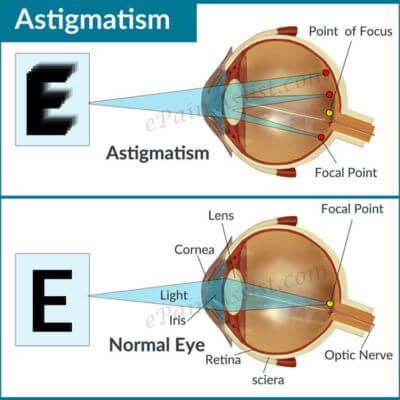Nearsightedness, Farsightedness, & Astigmatism: Which is Which?
Nearsightedness, farsightedness, and astigmatism are common vision errors. When we write a prescription for glasses, contacts, or LASIK, it’s usually for one of these issues. These disorders are often confused with each other. We broke them down to help you better understand your lens prescription.
Nearsightedness, farsightedness, and astigmatism result from the eye’s inability to focus light properly on the retina. Glasses and contact lenses correct these issues by adjusting light paths. LASIK offers a more permanent solution by reshaping the cornea. Presbyopia is an age-related condition that reduces the eye’s flexibility for close-up focus. It’s treated with reading glasses and multifocal lenses.
Nearsightedness, Farsightedness, and Astigmatism
Refractive errors are common vision problems . They’re caused by the eye’s inability to focus light onto the retina correctly. The main types include:
- Nearsightedness ( myopia ), where distant objects appear blurry
- Farsightedness ( hyperopia ), causing difficulty with close-up vision
- Astigmatis m, resulting in distorted or blurred vision due to irregular cornea shape
These errors occur when the shape of the eye or its lens disrupts the normal bending of light. This leads to imperfect image formation on the retina.
Nearsightedness
Nearsightedness is when you can see close-up objects clearly. However, you have difficulty seeing objects that are farther away, like road signs. Also referred to as myopia , it happens when the eyeball is too long . This causes light rays to hit a point in front of the retina instead of on its surface. Nearsightedness also happens when the cornea or lens of the eye is too curved for the eyeball’s length. Sometimes it’s for all the reasons listed above.
Farsightedness
Farsightedness occurs when you can see distant objects clearly but not up-close objects. This includes words on a page. Also referred to as hyperopia , it happens when the eyeball is too short . This causes light rays to hit a point behind the retina instead of directly on its surface.
Astigmatism
Astigmatism
is one of the most misunderstood refractive disorders. After prolonged periods of visual stimulation, people with astigmatism experience:
- Blurred vision
- Eye strain
- Headaches
This could be following reading a book or working on the computer for a long time.
Astigmatism happens when the cornea is misshapen rather than round and symmetrical. When symmetrical, light entering the eye hits directly on the retina’s surface. An asymmetrical cornea causes light rays to hit many points behind and/or in front of the retina. This leads to vision problems associated with astigmatism.
Astigmatism can also happen when the lens is misshapen. This is known as lenticular astigmatism .
Treatment Options for Refractive Disorders
Glasses and contact lenses are usually used to treat refractive errors. Glasses have lenses that alter the path of light, compensating for these imperfections. Contact lenses, worn directly on the eye, serve the same purpose.
Both options provide clearer vision by adjusting the way light enters the eye. This focuses light on the retina, alleviating the distortions associated with refractive errors.
LASIK
LASIK ( laser-assisted in situ keratomileusis ) is a more permanent solution to refractive errors. It corrects these errors by reshaping the cornea to the correct shape. Refractive surgery allows for quick recovery and reduced reliance on glasses or contacts. LASIK is a popular and effective option for correcting common refractive errors.
In this procedure, a laser removes a small amount of corneal tissue. This alters its shape, enhancing the eye’s focusing power. For nearsightedness, the cornea is flattened, while for farsightedness, it is steepened. For astigmatism, the corneal curves are smoothed out. The reshaped cornea allows light to focus properly onto the retina, improving vision.
Presbyopia
Presbyopia is a common age-related vision condition that usually emerges in the 40s . It’s caused by the gradual loss of flexibility in the eye’s lens. This affects its ability to focus on close objects.
As a result, individuals with presbyopia experience difficulty:
- Reading
- Working on a computer
- Performing tasks requiring close-up vision
Presbyopia is a natural part of aging. This makes it distinct from other vision issues like nearsightedness, farsightedness, and astigmatism. However, treatment for the condition is similar to those listed above.
Common solutions include:
- Reading glasses
- Bifocals
- Multifocal lenses
These help to compensate for the diminished ability of the eye to adjust and focus on nearby objects. Unfortunately, LASIK is not a possible treatment for those who have presbyopia.
Are you interested in LASIK or other treatments for your refractive disorder? Contact us today to schedule your appointment!
Nearsightedness, farsightedness, and astigmatism occur when the eyes can’t properly focus light on the retina. Glasses and contact lenses adjust light paths to address these issues. LASIK provides a lasting solution by reshaping the cornea. Presbyopia, an age-related condition, diminishes the eye’s flexibility for close focus. It can be managed with reading glasses and multifocal lenses but not LASI.
Baptist Eye Surgeons is an ophthalmological practice in Knoxville, TN, Morristown, and Sevierville. Call us at 865-579-3920 for more information or to schedule an appointment .
*This blog was originally published on July 18, 2017. It has been updated for clarity and freshness.


MORRISTOWN
SEVIERVILLE
TENNESSEE VALLEY - LASER CENTER
TENNESSEE VALLEY - EYE CENTER




